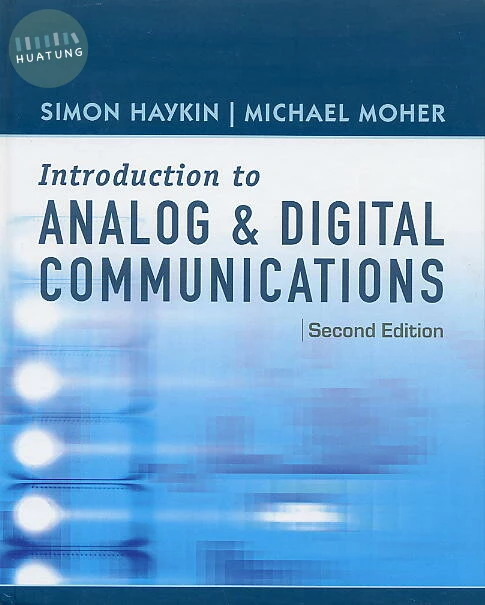
| 定價: | ||||
| 售價: | 299元 | |||
| 庫存: | 已售完 | |||
| LINE US! | ||||
| 此書為本公司代理,目前已售完,有需要可以向line客服詢問進口動向 | ||||
| 付款方式: | 超商取貨付款 |

|
|
| 信用卡 |

|
||
| 線上轉帳 |

|
||
| 物流方式: | 超商取貨 | ||
| 宅配 | |||
| 門市自取 |
為您推薦

類似書籍推薦給您
作(編/譯)者 : COUCH II 出版年份 : 2013 ISBN : 9780273774211 書號 : EX0463 幾色 : 1 規格 : 平裝 發行公司 : PEARSON 英文書名中譯 : 數位與類比通訊系統 版次 : 8E 頁數 : 784 Table of Contents: Chapter 1. INTRODUCTION Chapter 2. SIGNALS AND SPECTRA Chapter 3 BASEBAND PULSE AND DIGITAL SIGNALING Chapter 4 BANDPASS SIGNALING PRINCIPLES AND CIRCUITS Chapter 5 AM, FM, AND DIGITAL MODULATED SYSTEMS Chapter 6 RANDOM PROCESSES AND SPECTRAL ANALYSIS Chapter 7 PERFORMANCE OF COMMUNICATION SYSTEMS CORRUPTED BY NOISE Chapter 8 WIRE AND WIRELESS COMMUNICATION SYSTEMS Appendix A Mathematical Techniques, Identities, and Tables Appendix B Probability and Random Variables Appendix C Using MATLAB

類似書籍推薦給您
【簡介】 The digital age has driven the need to combine radio-frequency engineering experience with overall high-speed digital design, as well as the need for an overall understanding of system performance. In some advanced designs, both analog and digital disciplines have to exist and operate in the same space, and with the correct design, high performance is possible. This book is intended to provide a step-by-step guide to all aspects and tradeoffs from theory to application for fiber-optics transceiver electronics. Presenting a thorough compendium of information in a structured way, this book enables the engineer to develop a methodical design approach, a deep understanding of specifications parameters and the reasons behind them, as well as their effects and consequences on system performance, which are essential for proper component design. Further, a fundamental understanding of RF, digital circuit design, and linear and nonlinear phenomena is important in order to achieve the desired performance levels. Becoming familiar with solid-state devices and passives used to build optical receivers and transmitters is also important so one can effectively overcome design limitations. The book is organized into six main sections covering the following subjects: System Overview Semiconductors and Passives RF and Control Concepts Introduction to CATV MODEM and Transmitters Digital Transceiver Performance Integration and Testing 【目錄】 Nomenclature. Constants and Symbols. Preface. Acknowledgements. Part 1: System Overview. 1. WDM, Fiber to the X, and HFC Systems: A Technical Review. 2. Basic Structure of Optical Transceivers. 3. Introduction to ATV Standards and Concepts of Operation. Part 2: Semiconductors and Passives. 4. Introduction to Optical Fiber and Passive Optical Fiber Components. 5. Optics, Modules, and Lenses. 6. Semiconductor Laser Diode Fundamentals. 7. Laser Dynamics: External Modulation for CATV and Fast Data Rates. 8. Photodetectors. Part 3: RF and Control Concepts. 9. Basic RF Definitions and IMD Effects on TV Picture. 10. Introduction to Receiver Front-End Noise Modeling. 11. Amplifier Analysis and Design Concepts. 12. AGC Topologies and Concepts. 13. Laser Power and Temperature Control Loops. Part 4: Introduction to CATV MODEM and Transmitters. 14. Quadrature Amplitude Modulation (QAM) in CATV Optical Transmitters. 15. Introduction to CATV MODEM. 16. Linearization Techniques. 17. System Link Budget Calculation and Impairment Aspects. Part 5: Digital Transceiver Performance. 18. Introduction to Digital Data Signals and Design Constraints. 19. Transceivers and tunable Wavelength Transceiver Modules. Part 6: Integration and Testing. 20. Cross-talk Isolation. 21. Test Setups. Index.

類似書籍推薦給您

類似書籍推薦給您

類似書籍推薦給您
【簡介】 Simon Haykin has written two books with Wiley for Communications Systems, Introduction to Digital and Analog Communications, 2e and the forthcoming revision of his classic Communications Systems, 5e. The second edition of Introduction to Digital and Analog Communications, 2e is written at an accessible level and serves as an introductory treatment of communication theory, both ana-log and digital communications. Given the highly mathematical nature of communication theory, it is rather easy for the reader to lose sight of the practical side of communication systems. Throughout the book, the authors have made a special effort to move through the mathe-matical treatment at an easy-to-grasp level, and also to point out the practical relevance of the theory wherever it is appropri-ate to do so. Drs. Haykin’s other text, Communication Systems reaches out to a higher level of math rigor. Also, Introduction to Digital and Analog Communications, 2e offers the probability coverage later in the book (chapter 8) since probability theory is not critical to the understanding of modulation. This also contributes to the accessible approach of the text. Introduction to Digital and Analog Communications, 2e is self-contained and suited for a one or two-semester course in communica-tion systems taken by Electrical Engineering juniors or seniors. The book offers flexibility for organizing the course material to suit the interests of course professors and students. Reviewer Quotes: My current textbook by Proakis/Salehi: Communication Systems Engineering, 2e did not meet my student’s capabilities and expecta-tions. The textbook is too complicated and overloaded with heavy mathematical equations. The material is not always logically presented. Not to mention, there is 800 pages of text. I was impressed with Haykin/Moher’s: Introduction to Digital and Analog Communications, 2e and the straightforward comprehensive material coverage of the basic principles of communication theory. Also, the text is logically written with easy to follow and understand mathematical equations and examples. Absolutely, I would like to use this textbook for my communications systems class as soon as it will be possible.” Andrei Pet-rov- Idaho State University “ Overall, I found the concepts are clearly explained, the chapters are well motivated by their introductions, “Lessons to be learned” at the beginning of each chapter are particularly appealing, and concluded with well put summaries. A very well-written introductory text to grasp the basics of communication systems.” Aylin Yener-Penn State University